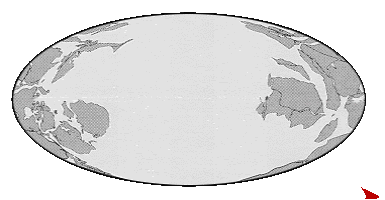The magnetic lineations in the ocean floor were first discovered using magnetometers designed for submarine detection. These isochrons are tenets of our notion of plate tectonics, yet many isochron patterns are inexplicable by our current tectonic model.
We have previously explored The Pacific Triangle, Charybdis and the Oldest Ocean Floor, and The Ring Around Antarctica. I had occasion to be perusing the Beaufort Sea Floor recently and discovered yet another astonishing set of discordant isochrons:
The geographic North Pole is just below and to the right of the only IODP drill site at the top of the image.
The shapes of isochrons are determined by the patterns of new ocean crust formation and crystallization. The sizes of isochrons depend on both the rate of magma extrusion and the time interval between geomagnetic reversals. Realistically, the magnetic data is messy a fair amount of interpolation goes into the even spacing of isochrons. For example, it is well known that between 83 and 121 million years ago, the longest known interval without a geomagnetic reversal took place. This is known as the Cretaceous normal superchron. If you look at this interval around the globe, you will see an even spacing of isochrons. The isochrons do not represent reversals.
What we see on the floor of the Beaufort Sea is two different systems of extrusion that took place immediately before the Cretaceous superchron. To the north is a small piece of typical seafloor extrusion between transform faults. This was very slow spreading compared with the Pacific ocean floor during this period. If we zoom in and add color we see something very strange going on.

The lightest color is 120mya ocean floor, the next lightest blue is 125mya, and so on in 5mya increments. There were multiple parallel extrusion fins, each its own miniature mid ocean ridge spreading both directions. This pattern held for 120mya, 125mya, 130mya, and less predominantly 135mya; before the transition to more rapid extrusion 140mya.
While this was going on in the North Beaufort Sea and Arctic Ocean, the South Beaufort shows its own weird extrusions roughly parallel to the North Beaufort.
In the center part of a system with more “normal” progression, there is a series of fins even more tightly packed than to the north. They are less linear, and more like individual plutons. Note the tiny sliver of 120mya to the right against the continental shelf.
There are no trenches up here to relieve the pressure.
Zooming out to where the modern spreading ridge ends unceremoniously in the Laptev Sea, we can see that this perpendicular system is discontinuous in a line of seamounts to the left that must have been a trench. This view is basically looking straight down on the North Pole.
The green to blue color contrast basically separates extrusion before and after the Cretaceous Superchron. Very little, if any, extrusion took place at the North Pole during this interval.










Pingback: The Cretaceous Superchron, Beaufort Isochrons, and the Motion of North America | geosciencebigpicture